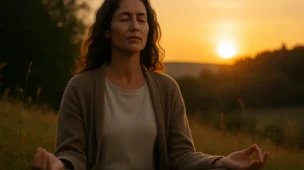Reading time: 4 minutes
Breathing is the most natural thing we do—so automatic that we rarely stop to notice it. Yet within each breath lies a powerful tool for healing, balance, and self-awareness. Conscious breathing, or mindful breathing, isn’t just a trendy wellness concept. It is a deeply rooted practice in many ancient traditions and modern therapies that brings real physiological and emotional benefits.
In this article, we explore the science, spirituality, and practical techniques of conscious breathing—and how it can be a gateway to transformation.
Why Breathing Deserves Attention
Most people take between 17,000 and 30,000 breaths each day. But how many of those breaths do we take with awareness?
Breath is unique because it’s both involuntary and voluntary. While the body breathes on its own, we can also control it. This makes breath a bridge between the autonomic nervous system (which runs in the background) and our conscious mind.
When we pay attention to our breath, we gain direct access to calming our nervous system, shifting our mental state, and even rewiring long-held emotional patterns.
The Science of Conscious Breathing
Modern studies in neuroscience and psychology have confirmed what yogis and meditators have known for centuries: breath affects the mind and body deeply.
Here’s what happens physiologically when you breathe slowly and deeply:
- Heart rate decreases, leading to a sense of calm
- Cortisol levels drop, reducing stress
- The vagus nerve activates, stimulating relaxation
- Oxygen levels stabilize, improving brain function
- Mindfulness increases, enhancing emotional regulation
Breathing consciously can interrupt the “fight-or-flight” cycle and activate the parasympathetic nervous system, also known as the “rest and digest” mode.
Ancient Roots of Breath Practices
Breath has been central in many spiritual traditions:
- In yoga, breath control is called pranayama, which means “life force expansion.”
- In Buddhism, following the breath is a foundational meditation practice.
- In Taoism, breath is seen as a link to energy flow or qi.
- In Christian mysticism, breath is symbolic of the Holy Spirit—literally “the breath of God.”
In every tradition, breath is more than just air—it’s a sacred act, a channel between the seen and unseen, body and soul.
The Emotional Body and the Breath
Our breath reflects our inner world. When we’re anxious, we breathe rapidly and shallowly. When we’re relaxed, our breath deepens. The relationship goes both ways: how we breathe affects how we feel, and how we feel affects how we breathe.
Conscious breathing helps you:
- Become aware of hidden emotional tension
- Release stuck energy from past experiences
- Feel safer in your body
- Respond rather than react in stressful moments
It becomes a gentle companion in processing grief, anxiety, and even joy.
Simple Breathing Techniques You Can Start Today
Here are some accessible breath practices you can begin using right away:
1. Box Breathing
Used by Navy SEALs and meditation teachers alike, box breathing is calming and centering.
How to do it:
- Inhale for 4 counts
- Hold for 4 counts
- Exhale for 4 counts
- Hold for 4 counts
Repeat for 4–8 rounds.
2. 4-7-8 Breathing
This breath technique promotes deep relaxation and can help with sleep.
How to do it:
- Inhale through your nose for 4 counts
- Hold your breath for 7 counts
- Exhale slowly through your mouth for 8 counts
Repeat for 4 rounds or more before bed.
3. Alternate Nostril Breathing (Nadi Shodhana)
Balances the brain and calms the mind.
How to do it:
- Close your right nostril and inhale through the left
- Close your left nostril and exhale through the right
- Inhale through the right, then exhale through the left
That’s one round. Continue for 5–10 rounds.
Breathing into the Present Moment
Breath is always now. You can’t breathe for the past, and you can’t breathe for the future. So each conscious breath becomes a return to the present moment—a return to yourself.
This is where healing begins—not by escaping life, but by breathing into it, exactly as it is.
Use breath to:
- Ground yourself during difficult conversations
- Center before making a big decision
- Connect with your body in moments of anxiety
- Anchor your awareness during meditation
Breath as a Spiritual Practice
Breath is life. In many cultures, the word for “spirit” and “breath” are the same—like the Hebrew word ruach or the Sanskrit prana. When you become aware of your breath, you’re not just regulating your body. You’re entering a sacred space. Each inhale is a receiving. Each exhale is a releasing.
By practicing conscious breathing, you begin to:
- Feel connected to something greater
- Cultivate gratitude for life itself
- Experience moments of transcendence or unity
Breathing becomes a prayer without words.
Building a Breath Ritual
Like any meaningful habit, consistency is key. Here’s how to make conscious breathing part of your daily rhythm:
- Set a timer for 3–5 minutes each morning to breathe mindfully
- Use breath as a transition tool—before meals, meetings, or sleep
- Practice breathwork during nature walks, focusing on the rhythm
- End the day with 4-7-8 breathing as a signal to wind down
The goal isn’t to breathe “perfectly,” but to breathe with awareness.
Final Thought: Return to the Breath, Return to Yourself
Life will pull us in every direction. We’ll face stress, distraction, and emotional waves. But the breath is always here—quiet, faithful, and ready to guide us back to balance.
You don’t need equipment, a perfect mindset, or hours of time. Just this moment. Just one breath. And then the next.
That’s where healing begins.



